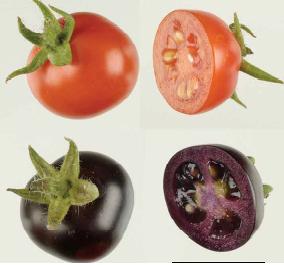I had my first brush with a genetically-modified organism this week – and was pleasantly surprised at the experience.

When I learned a trip to the John Innes Centre at Norwich Research Park would include a tour of the greenhouses used by Professor Cathie Martin to include her genetically modified, purple tomatoes, I expected to be handed a haz-mat suit, to have all questions of the scientists vetted by a PR officer and to have to submit to biometic scanning just to get in the front door.
None of the above was involved. In a fairly standard greenhouse tucked away at the back of the John Innes Centre campus sit a collection of pots containing tomato plants. The tomatoes growing on the plants look like any other tomatoes in the early stages of growth other than for the fact that they are a rich purple in colour.
The eggplant-like hue of the skin and flesh of the tomatoes is due to the fact that they have been altered with genes from snapdragon flowers, As a result they contain very high levels of antioxidant pigments called anthocyanins.
The genetic modification means the tomatoes are similar to blackberries, blueberries and currants, in that they are high in antioxidants, which research shows may contribute to combating cancer and heart disease.
 So why not just encourage people to eat more blackberries, blueberries, cranberries and currants? Well, as Professor Martin pointed out when this exact question was asked by a colleague this week, berries are expensive to produce in large quantities and less suitable for growth all over the world than tomatoes are. Tomatoes on the other hand are already a favourite food for millions – especially when they can be pureed and spread on pizzas and liquified to make a Bloody Mary.
So why not just encourage people to eat more blackberries, blueberries, cranberries and currants? Well, as Professor Martin pointed out when this exact question was asked by a colleague this week, berries are expensive to produce in large quantities and less suitable for growth all over the world than tomatoes are. Tomatoes on the other hand are already a favourite food for millions – especially when they can be pureed and spread on pizzas and liquified to make a Bloody Mary.
The details of the genetic modification undertaken by Professor Martin is outlined in this paper. Effectively, it involved taking genes from the snapdragon flower and using them as a sort of switch in tomatoes to amplify their anthocyanin-producing ability. Tomatoes already produce anthocynanin, so the GM variety effectively become supercharged with antioxidants.
The big question is whether the purple creations are safe for humans to eat. Professor Martin is careful to point out that she doesn’t yet know. Experiments with mice, which were specially bred to be prone to cancer, showed that when fed with powder 10 per cent derived from the purple tomatoes, the mice lived on average 30 per cent longer than those fed regular tomatoes or which didn’t receive tomatoes at all.
The next step is to find volunteers to eat the tomatoes so some evidence-based research can be carried out to determine the effects of eating the tomatoes on humans. Purple tomatoes anybody? As such, a commercial release of the tomatoes is some way off.
The United Kingdom, like New Zealand has very stringent restrictions on GM trials – recently a GM trial at Crop & Food (now Plant & Food Research) was shut down due to a containment breach and applications by Agresearch to undertake GM trials were overturned after being challenged in court.

GM is a challenging subject for everyone concerned. But what struck me at the John Innes Centre, was the openness with which the research there is being communicated. The scientists involved believe the tomatoes offer significant health benefits to humans in that they fight chronic illnesses and even degenerative diseases. But they know they are in the early stages of determining whether this in fact is the case.
In the meantime, they seem keen to talk about the science and the genetic tinkering involve – which is this particular case doesn’t appear to be too complex.
The sensitivity around the issue of GM – exacerbated in New Zealand by the recent setbacks to GM research, means that often scientists are reluctant to talk about the science.
Would a similarly open approach to GM trials in New Zealand help break down the often considerable barriers between scientists involved in genetic modification experiments and the public?
I’m not sure, but open days for the public at scientific institutions involve din GM (as long as they would not run significant risk of containment breaches) would seem like a good way to encourage people to make up their own minds based on some first-hand experience. Maybe we can learn a thing or two from what is going on in that Norwich hothouse.
Hi Peter, Glad to see you back from England gathering your GE stories. However I would like to point out that you have failed to truly reflect the reality of the tomato story. We already have an array of non hybrid heritage tomatoes of which many are purple and contain extremely high levels of anthocyanins. see http://en.wikipedia.org/wiki/Cherokee_purple). These are available to the public for the normal price of tomato seeds, no patents no foreign genes from other plants, proven safe over the millenia, non sterile saveable seed and highly nutritious also they are the size of beafsteak tomatoes not tiny toms. What is the reason that you want to promote GE purple tomaotoes as an unbiased journalist you should cover both sides of the story.
Hi Claire, I think the answer may lie in this BBC story about the purple tomatoes… “anthocyanins accumulated in tomatoes at higher levels than anything previously achieved in both the peel and flesh of the fruit, giving them an intense purple colour”. http://news.bbc.co.uk/2/hi/health/7688310.stm
I don’t have any ideological viewpoint on GM one way or the other, all I am out to promote is good science, something which is often absent from the GM debate.